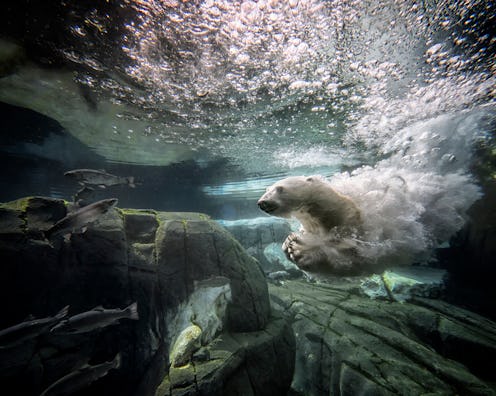News
Climate Change Forced A Starving Polar Bear To Rummage Through Trash For Food And The Video Is Heartbreaking

During a visit to Canada over the summer, a conservationist group stumbled upon a heartbreaking reminder of the impact climate change is having on wildlife: An emaciated polar bear rummaging through the trash for food, failing to to find any and ultimately collapsing onto the ground. The photographer who filmed the scene believes that the bear died later that day, and he published the footage to illustrate the devastating effects of global warming has on individual animals.
"When scientists say bears are going extinct, I want people to realize what it looks like," Paul Nicklen, who described the footage as "soul-crushing," told National Geographic. "Bears are going to starve to. This is what a starving bear looks like."
Polar bears survive almost entirely on seals, and seals in the arctic spend much of their lives on sea ice. But thanks to climate change, the Arctic is warming at nearly twice the global rate, causing those crucial ice sheets to melt. This has a catastrophic effect on both polar bears and seals: Less sea ice makes it harder for polar bears to find their main source of food, while the premature melting of sea ice often separates seal pups from their mothers before they can survive on their own. For polar bears, fewer ice sheets also increases the risks of reproductive failure due to lack of food and confrontation with humans on land, both of which further imperil the bears' survival.
Unsurprisingly, multiple studies have shown that less sea ice means higher death rates for polar bears (and seal pups). As a result, the International Union for the Conservation of Nature has warned that global polar bear populations may plummet by 30 percent by 2050.
Nicklen is part of Sea Legacy, a conservation group that focuses on ensuring "healthy and abundant oceans, for us and for the future," according to its website. He and his fellow filmmakers were at Canada's Baffin Islands over the summer when they spotted the skin-and-bones polar bear on land, dragging its foot on the ground due to what appeared to be muscular atrophy and unsuccessfully digging through an Inuit trash can in search of food.
"My entire @Sea_Legacy team was pushing through their tears and emotions while documenting this dying polar bear," Nicklen wrote in an Instagram post with the footage. "It’s a soul-crushing scene that still haunts me, but I know we need to share both the beautiful and the heartbreaking if we are going to break down the walls of apathy."
Nicklen told National Geographic that since posting the footage earlier in the week, many people have asked him why he didn't intervene.
"Of course, that crossed my mind," Nicklen told the magazine. "But it's not like I walk around with a tranquilizer gun or 400 pounds of seal meat."
Feeding polar bears is also illegal in Canada. Perhaps most importantly, giving the bear food on that day wouldn't have solved the root problem, which is that there simply wasn't enough food in the bear's natural habitat for it to survive.
"People think that we can put platforms in the ocean or we can feed the odd starving bear," Nicklen wrote on Instagram. "The simple truth is this — if the Earth continues to warm, we will lose bears and entire polar ecosystems. This large male bear was not old, and he certainly died within hours or days of this moment. But there are solutions. We must reduce our carbon footprint, eat the right food, stop cutting down our forests, and begin putting the Earth —our home — first."